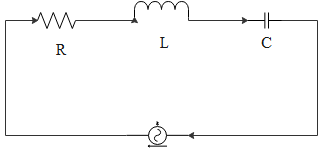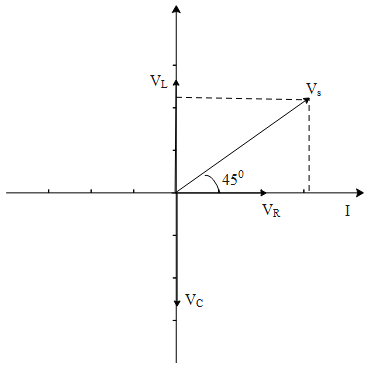
In a circuit L,C and R are connected in series with an alternating voltage source of frequency f. The current leads the voltage by ${{45}^{\circ }}$. The value of c is,
$\begin{align}
& \left( A \right)\dfrac{1}{\pi f\left( 2\pi fL-R \right)} \\
& \left( B \right)\dfrac{1}{2\pi f\left( 2\pi fL-R \right)} \\
& \left( C \right)\dfrac{1}{\pi f\left( 2\pi fL+R \right)} \\
& \left( D \right)\dfrac{1}{2\pi f\left( 2\pi fL+R \right)} \\
\end{align}$
Answer
558.3k+ views
Hint: First find the nature of the circuit. Here the circuit is capacitive. The tan of the angle is the ratio of the difference between capacitive reactance and inductive reactance to the resistance. Where inductive reactance is the product of inductance and angular frequency. Similarly, capacitive reactance is the product of capacitance and angular frequency. By substituting these values and substituting we get the value of capacitance.
Complete step by step solution:

The circuit is capacitive. Thus,
${{X}_{C}}\rangle {{X}_{L}}$
$\phi ={{45}^{\circ }}$
$\tan \phi =\dfrac{{{X}_{C}}-{{X}_{L}}}{R}$
$\tan {{45}^{\circ }}=1$
$\Rightarrow {{X}_{C}}-{{X}_{L}}=R$
$\Rightarrow {{X}_{C}}=R+{{X}_{L}}$
Inductive reactance, ${{X}_{L}}=\omega L=2\pi fL$
$\dfrac{1}{\omega c}=\dfrac{1}{\omega \left( \omega L+R \right)}$
$\Rightarrow c=\dfrac{1}{\omega \left( \omega L+R \right)}$
where, $\omega =2\pi f$
$\therefore c=\dfrac{1}{2\pi f\left( 2\pi fL+R \right)}$
Hence, option (D) is correct.
Phasor diagram,

So, the correct answer is “Option D”.
Additional Information: Inductive reactance is the name given to a changing current flow. The impedance is usually measured in ohms, just like resistance. That is, the inductive reactance has the same unit of resistance. Capacitive reactance decreases with the increasing value of AC frequency, while inductive reactance increases with increasing AC frequency. When current passes through a coil, then it will become electromagnetic. The current that flows through the coil will have an opposition like resistance upon its inductance and frequency waveform. Where inductive reactance is the product of inductance and angular frequency. Similarly, capacitive reactance is the product of capacitance and angular frequency. By substituting these values and substituting we get the value of capacitance.
Note: Also the inductive reactance has the same unit of resistance. That is, both are measured in ohms. The inductive reactance is proportional to the angular frequency of AC voltage source. Where inductive reactance is the product of inductance and angular frequency. Similarly, capacitive reactance is the product of capacitance and angular frequency. By substituting these values and substituting we get the value of capacitance.
Complete step by step solution:

The circuit is capacitive. Thus,
${{X}_{C}}\rangle {{X}_{L}}$
$\phi ={{45}^{\circ }}$
$\tan \phi =\dfrac{{{X}_{C}}-{{X}_{L}}}{R}$
$\tan {{45}^{\circ }}=1$
$\Rightarrow {{X}_{C}}-{{X}_{L}}=R$
$\Rightarrow {{X}_{C}}=R+{{X}_{L}}$
Inductive reactance, ${{X}_{L}}=\omega L=2\pi fL$
$\dfrac{1}{\omega c}=\dfrac{1}{\omega \left( \omega L+R \right)}$
$\Rightarrow c=\dfrac{1}{\omega \left( \omega L+R \right)}$
where, $\omega =2\pi f$
$\therefore c=\dfrac{1}{2\pi f\left( 2\pi fL+R \right)}$
Hence, option (D) is correct.
Phasor diagram,

So, the correct answer is “Option D”.
Additional Information: Inductive reactance is the name given to a changing current flow. The impedance is usually measured in ohms, just like resistance. That is, the inductive reactance has the same unit of resistance. Capacitive reactance decreases with the increasing value of AC frequency, while inductive reactance increases with increasing AC frequency. When current passes through a coil, then it will become electromagnetic. The current that flows through the coil will have an opposition like resistance upon its inductance and frequency waveform. Where inductive reactance is the product of inductance and angular frequency. Similarly, capacitive reactance is the product of capacitance and angular frequency. By substituting these values and substituting we get the value of capacitance.
Note: Also the inductive reactance has the same unit of resistance. That is, both are measured in ohms. The inductive reactance is proportional to the angular frequency of AC voltage source. Where inductive reactance is the product of inductance and angular frequency. Similarly, capacitive reactance is the product of capacitance and angular frequency. By substituting these values and substituting we get the value of capacitance.
Recently Updated Pages
Master Class 12 Business Studies: Engaging Questions & Answers for Success

Master Class 12 Social Science: Engaging Questions & Answers for Success

Master Class 12 English: Engaging Questions & Answers for Success

Master Class 12 Chemistry: Engaging Questions & Answers for Success

Class 12 Question and Answer - Your Ultimate Solutions Guide

Master Class 12 Economics: Engaging Questions & Answers for Success

Trending doubts
What are the major means of transport Explain each class 12 social science CBSE

Which are the Top 10 Largest Countries of the World?

Draw a labelled sketch of the human eye class 12 physics CBSE

How much time does it take to bleed after eating p class 12 biology CBSE

Explain sex determination in humans with line diag class 12 biology CBSE

When was the first election held in India a 194748 class 12 sst CBSE




